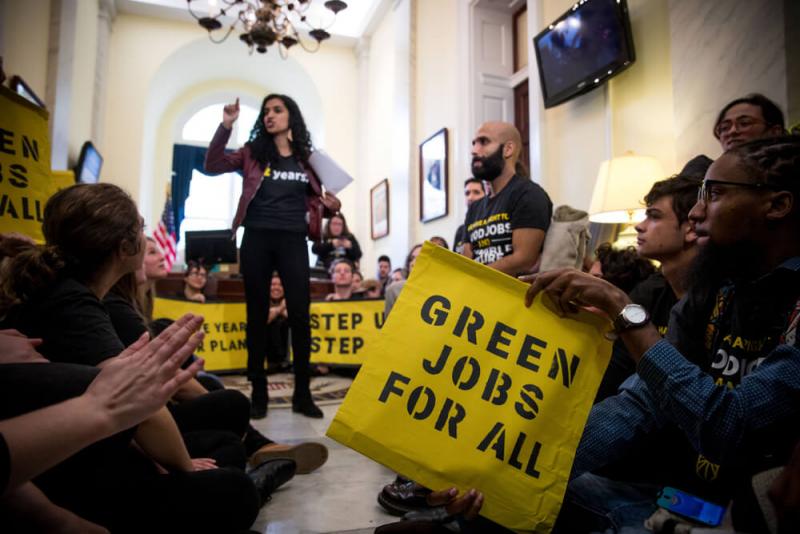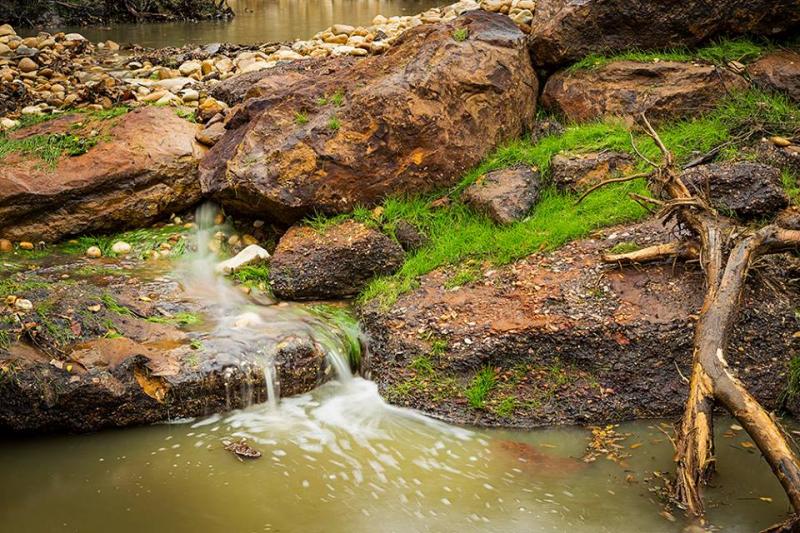A recent U.S. climate assessment made headlines last week for its conclusion that the victims of climate change are no longer some future generation, but us — and we’re feeling the effects now.
Three days after the Trump administration published the report — on the biggest shopping day of the year — Katharine Hayhoe, one of the authors, appeared in a webinar hosted by nonprofit news network, Climate Central, where she stressed that climate change is real, serious, and the “window of time to prevent widespread dangerous impacts is closing fast.”
Climate change will not affect everyone equally, the report shows, but no one is slated to be left untouched.
In addition to more extreme temperatures and climate disasters such as fires and floods, the 1,656-page assessment projects increased risks or failures to “critical systems including water resources, food production and distribution, energy and transportation, public health, international trade, and national security.”
While the report paints a dire future, Hayhoe says, “fear and panic are not going to fix the problem.” Rather, what we need is “long-term sustained action and hope for a better future.”
Some are already aiming to get us there — spurred on by their faith that it’s not too late. The question is: Will their efforts be enough?
From Grassroots to Government
In early November, a group of young adults grabbed the nation’s attention when they stormed House Minority Leader Nancy Pelosi’s office. Wearing shirts that read, “WE HAVE A RIGHT TO GOOD JOBS AND A LIVABLE FUTURE,” the protesters demanded that Pelosi lead the Democrats in combating climate change. When Representative-elect Alexandria Ocasio-Cortez joined the sit-in, the group, known as the Sunrise Movement, found themselves gracing the pages of publications such as The Washington Post, Vox, and The New Yorker.
“Everything has blown up since we, along with Alexandria Ocasio-Cortez, introduced this resolution for a Green New Deal,” William Lawrence, one of the co-founders of the Sunrise Movement told Sojourners. “Before Election Day, I would have told you that we have tens of thousands of supporters and several hundred active volunteer members. Now, I would venture to say we have over a thousand active members putting in real work on a weekly basis and hundreds of thousands, if not millions, of supporters.”
While Lawrence has been pleased to see the movement gain recognition over the past month, he stresses that their growing influence was not an accident, but rather a result of the groundwork they have been laying since their founding a year and a half ago.
Rachael Warriner / Shutterstock.com

Before helping launch the Sunrise Movement, Lawrence was involved with other youth-led organizing around climate change. He worked to divest university endowments from fossil fuels, supported efforts against the Keystone XL pipeline, and encouraged the United Nations to insist on climate justice. While he had seen progress in certain areas, he and others felt none of it was adding up to the scale they needed.
“We decided to take some time away from the daily grind of tasks and organizing to make a plan that we believed could actually help us build political power at the scale of the climate crisis,” he said.
What resulted was the Sunrise Movement, a self-described “army of young people” that utilizes grassroots organizing to influence the political system.
While President Trump has fanned the flames of climate change denial since taking office, Lawrence doesn’t see a lack of awareness as the greatest challenge to the movement.
“You hear a lot of excuses for why we can’t get this done, but the truth is that the barriers are political,” Lawrence said. “Our government has been captured by billionaire fossil fuel executives who will burn the planet and destroy our society for the sake of making another billion dollars pumping and selling oil.”
In their original four-year plan, the Sunrise Movement stated that by 2019, they wanted to make climate change a top-five national political issue and a major part of the Democratic primary for president. In late November, they seemed to have accomplished that. On Nov. 26, a USA Today article ran with the headline, “Once Democrats take charge of the House, addressing climate change will become top priority again.”
But that’s just the beginning.
“The politics of climate change are transforming beneath our feet and we need to do everything we can and not rest on this moment of success,” Lawrence said. “We haven’t won yet.”
A Green New Deal
Much of the Sunrise Movement’s work centers around the passing of the Green New Deal — a policy proposal modeled after Franklin D. Roosevelt’s New Deal that calls for a transition to 100 percent green renewable energy by 2030 and a divestment from fossil fuels, including natural gas. It’s a seemingly ambitious plan, but one that Lawrence says is practical and sustainable.
Not only does the Green New Deal address climate concerns, but it also tackles what Lawrence refers to as the “jobs versus environment myth.”
The plan includes a job guarantee program that ensures that anybody who wants a living wage would have one. In fact, the deal promises up to 20 million new, living-wage jobs and would make the government the, “employer of last resort with a much-needed major public jobs program.”
Yes, the Green New Deal will cost money to implement. But according to a HuffPost article authored by a professor of economics and a climate action policy and data researcher, the “Green New Deal will actually help the economy by stimulating productivity, job growth, and consumer spending, as government spending has often done.”
For Lawrence, the Green New Deal is more than an economic imperative — it’s a moral one.
“We have an opportunity to lay the foundation for a whole new common sense around what constitutes environmental protection and implement new and more ambitious policies that will pay dividends for generations to come and that’s what gives me hope,” Lawrence said. “We have an opportunity to witness a moral revitalization of the country.”
Three groups he says are providing the moral leadership for the movement: young people, Indigenous people, and people of faith.
A Moral Opportunity
Susan Hendershot, president of Interfaith Power & Light, a national organization that reaches more than 20,000 congregations, knows personally the need for the faith voice in the climate movement.
“We talk about climate change as a moral issue, and that’s certainly true,” Hendershot said. "I also think about it as a moral opportunity, which is maybe a slightly more hopeful framing. The moral opportunity is really knowing that people of faith can lead the way — that we’re called to shine the light in the darkness and bring people together for a vision towards this more hopeful world.”
Hendershot has already seen congregations working to combat climate change through becoming carbon neutral facilities.
“They’re investing in solar, they’re putting in geothermal, or they’re doing work on the land they own,” she said. “Congregations are sort of on the forefront of solutions.”
St. Luke’s Episcopal Church in Annapolis, Md. is one such church casting a vision for the future.
In 2013, Betsy Love, a member of St. Luke’s, took a walk through her church’s property. A fellow member of the church had approached Love about building a nature trail through the four acres of undeveloped land behind the building. Love attempted to walk through the property, but found it so heavily degraded that she couldn’t make it to the other side. While walking back to the street, Love noticed a stormwater drain. She says that that is when it all came together.
Love could tell from the topography of the land that a stream had once flowed through the property, carrying stormwater to the creek at the tip of the property and ultimately, back out to the ocean. She approached the pastor of the church, Rev. Diana Carroll, and together they launched an ambitious project: restoring the property to its original state, stream and all.
“The idea that developed was to build a series of natural structures that would filter the stormwater and allow it to soak into the ground and replenish the groundwater so that it is 70 to 80 percent cleaner by the time it reaches the creek,” Carroll said.
The church and community members joined forces to restore the property to what, as Love said, it was before colonization. They dug bioswales, huge trenches that would help replenish the aquifers that Love believes had not received water infiltration since the 1950s, and designed a wetland and tidal marsh. They removed invasive vines and plants and replaced them with native shrubs and trees. Then they gave it a name: “Restoration of Nature.”
“We chose the name ‘Restoration of Nature,’ because we were really seeking to restore this whole ecosystem and let it become self-sustaining,” Carroll said.
22852896_2042313062664139_8719987958359357570_n.jpg

What they didn’t realize when they began the project five years ago, was the extent to which they were engaging in climate change resiliency.
“That’s been an exciting part of it as we share with others the ways in which [the project] is about much more than water and good habitat for waterfowl and frogs,” Carroll said. “Really, it is also helping us address climate change.”
While microbes in the stream clean the stormwater of excess sediment and nitrogen from fertilizers, the forest canopy consumes excess carbon and keeps temperatures cool.
However, what the city of Annapolis has taken the most note of is the project’s ability to fight flood tides. For years now, streets in downtown Annapolis have been flooding as ocean levels have risen and storms intensified. Love, who went through the Anne Arundel Watershed Stewards Academy to become a master watershed steward, explained that the area floods because the concrete foundation has no way of absorbing the higher tides. While stormwater pipes may have worked in the past, climate change has rendered them less efficient at keeping the streets free from what the city has come to refer to as “nuisance flooding.”
“Because in Maryland and other parts of the country we’ve been depleting our groundwater over the years, there are many places where the ground is actually subsiding,” Carroll explained. “So, in combination with the rising sea levels, it’s making these coastal areas increasingly vulnerable since the land is sinking at the same time the water is rising. Because our project focuses on getting the water to seep down into the ground and refill the aquifers, it’s actually counteracting that subsidence and preventing the sinking of land.”
Love believes the Restoration of Nature project is, “setting a precedent of how we should go forward.”
Signage throughout the property notes the function of each aspect of the project making the project not just effective, but educational.
“There’s at least one that talks about the positive impacts of the forest canopy for carbon sequestration and climate change,” Carroll said. “So people are learning from it simply by walking through it.”
Love and Carroll hosted an official dedication ceremony in September. Their long-term vision is that the project serve as a site of environmental literacy where they can educate students, adults, and legislators and encourage them to do similar projects in their own communities and, Carroll adds, “even in their own backyards.”
When it comes to climate change, Carroll notes that, “bold action and big changes are needed.” However, “small steps can make a big impact” — even in small spaces.
“What we really need to be doing now, as we see that the basic life-giving properties are being threatened, is go back and read carefully those words of Genesis and tend to the earth,” Love said. “It’s precious, even storm water —as dirty as it is."
Got something to say about what you're reading? We value your feedback!







